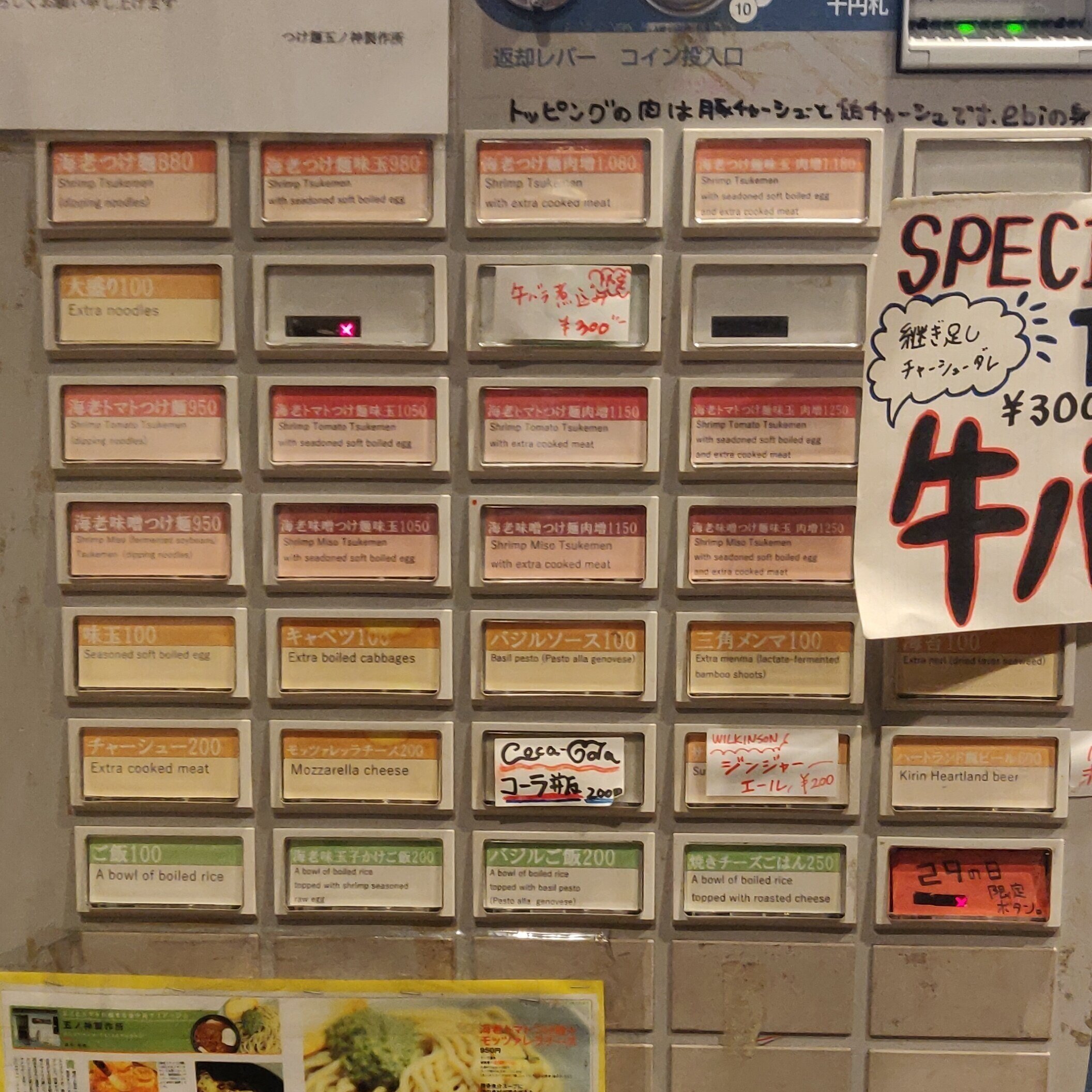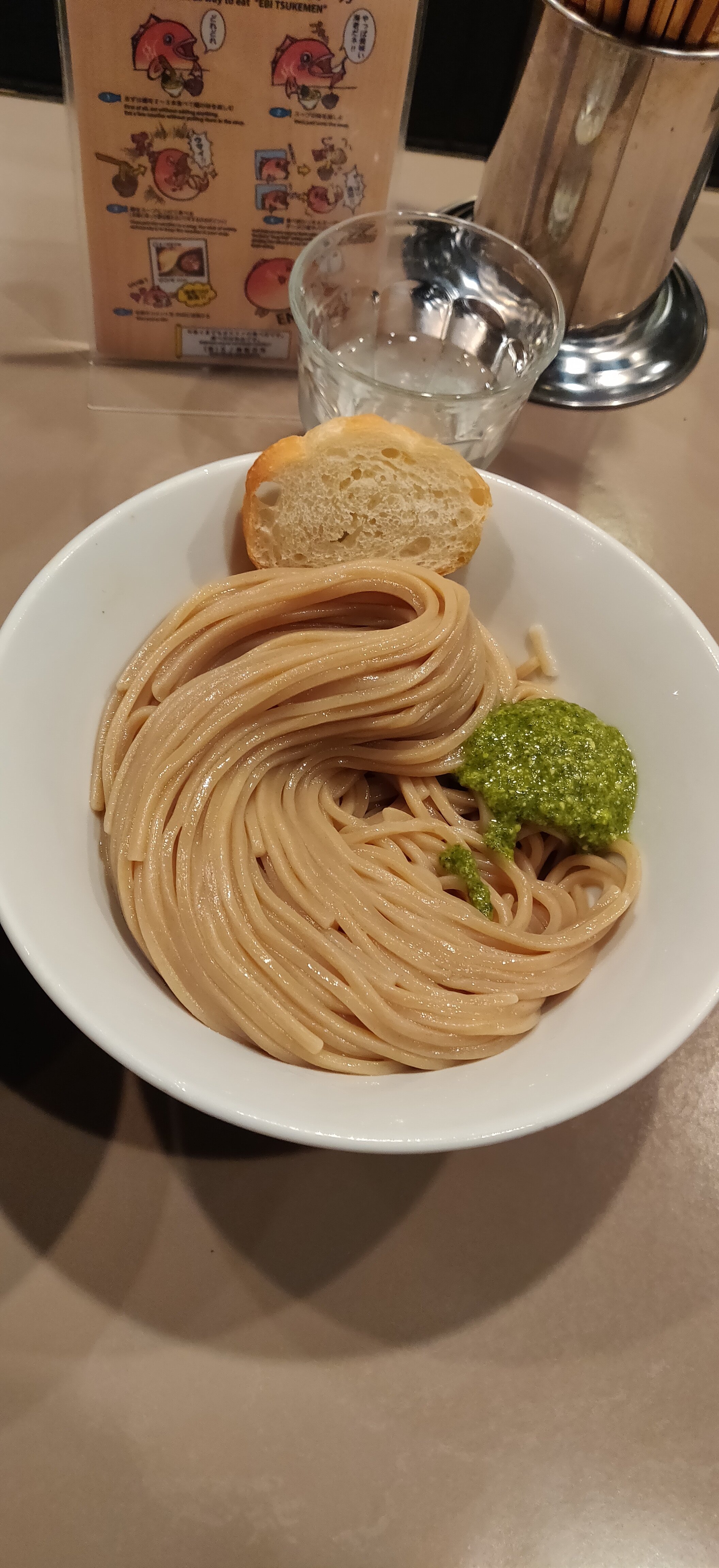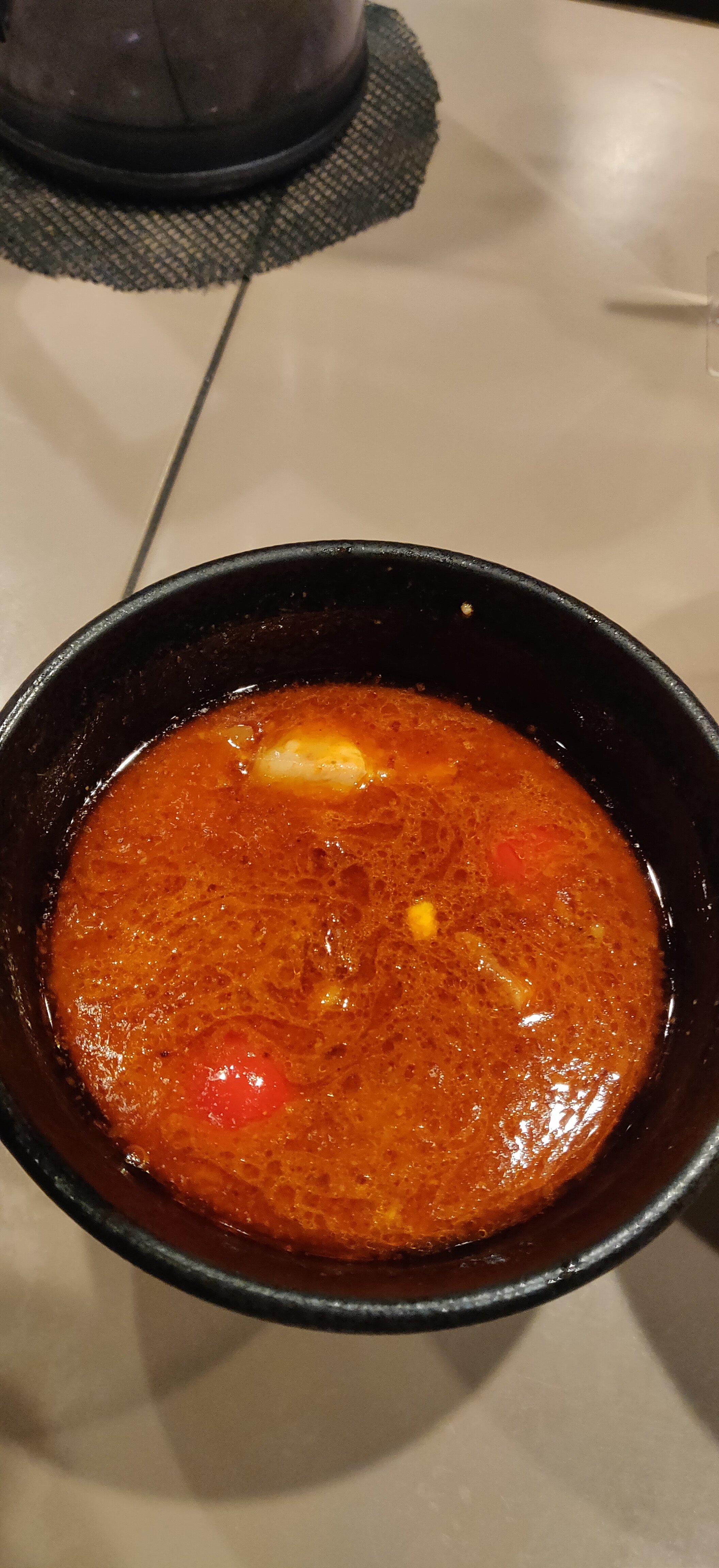Gonokami Seisakujyo (五ノ神製作所); Shrimp Tsukemen Experts, Shinjuku
So on my ramen tours that I run through AirBnB experiences, I take guests around Shinjuku and the amazing ramen the city has to offer. First stop is a must, and one I’ll only divulge to customers of my tours, but for the second shop, I like the gauge the taste buds of my guests and give them a list of shops to choose from before making a decision for the second bowl. Gonokami Seisakujyo is one of the options I list, but is rarely chosen as the sound of shrimp and Tsukemen tends to throw people off and running in another direction. However, in my personal opinion, it’s one of my favorites and a shop I visit frequently, even for personal visits. In fact I’ve actually visited all of the ramen restaurants operated by the owners of Gonokami Seisakujyo, including their original location Itsuki in west Tokyo, Gonokami Seinikuten near Hamura, and Gonokami Suisan by Akihabara. All of their locations are incredibly good and worthy of a visit, but if you’re staying in central Tokyo, this is likely the closest option and the easiest for you to get to. Gonokami Seisakujyo only offers shrimp tsukemen in three flavor varietals so if you have a shrimp allergy, unfortunately you won’t find anything here to eat. If you have a dislike for shrimp, again, this is not the shop for you. For everyone else, if you’re looking for a unique twist on the tsukemen, definitely expand your ramen experience here for some fantastic bowls.
Gonokami Seisakujyo is located just a short five minute walk from the Shinjuku Southeast exit of the JR lines. The shop is technically located in Shibuya city as the city lines goes through the south side of the station, but I include it in my Shinjuku Ramen list since Shinjuku is the closest station to the shop. Given the shops location in central Tokyo, they get a fair share of foreign clientele, so unlike their original Itsuki location in West Tokyo, they do provide English on their ticket machine so I’ll skip the translations for this shop and go straight to the review. Gonokami Seisakujyo only serves their Tsukemen in three different flavor varieties so no regular ramen here. Each Tsukemen has a shrimp broth base, but the tare, or seasoning sauce, they use for each one is different, making each one a completely new experience despite its shared broth. The three tsukemen here are the original, tomato shrimp, and miso shrimp tsukemen. I’ve had all three, but I must have had a brain freeze when I had their miso version as I don’t have photos of it. I’ll describe all three here and add in photos of the miso tsukemen next time I visit the shop. The most recommended item is the regular tsukemen followed by the unique tomato version and finally the miso. My review will go in that order and you can decide which to get if you ever decide to dine here.
Starting with the Regular Shrimp Tsukemen, this option gives you the most efficient way of tasting the shrimp broth in it’s purest form. There aren’t a ton of shrimp broth ramen restaurants and even fewer who feature a tsukemen version so this bowl will give you a baseline to compare any future ones you might have. What makes it so difficult is the cooking process where you’ll have to gently simmer shrimp shells with a good ratio of water and oil to extract all of the flavors without burning and overheating it. This requires constant stirring and a long simmer on low heat, so the man power needed for the broth is more strenuous than say a Hakata style tonkotsu soup that can be left on high heat without much attention to it. And of course, since this is a Tsukemen, the broth has to be condensed so it pairs with the thick, chewy noodles meaning the broth is further reduced in to what you see served in front of you. To put it simply, I would not want to be the guy paying the gas bills for this restaurant. The seasoning is quite simple, in a soy sauce base, but not too strong to overpower the shrimp broth. It serves only to add a bit of salty, savoriness to the soup, enhancing the shrimp flavors rather than mask it. Natural oils from the shrimp serves the role of adding fats to the soup. All of the components are emulsified nicely in to one consistent dipping soup perfectly heated as soon as its placed in front of you.
Hidden within the soup is a few cubes of pork char siu, thick cuts of menma bamboo shoots and a few sprinkles of green onions. If you add a soft boiled egg, you’ll find it hidden within this soup. To the side, with the noodles is the dried nori seaweed and several cuts of cabbage. As the soup is quite emulsified and creamy, you need a bit of fresh vegetables to cut through the denseness of the broth. Cabbage was the perfect choice as it doesn’t have a ton of flavor, but the texture and neutral taste profile counterbalances the rich shrimp flavor. Noodles are consistent throughout the three flavor varietals and have a fantastic wheat flour aromas. You can see the wheat notes from the visuals alone as a brown hue shimmers in the backdrop of the white bowl. Noodles are cooked, then shocked in cold water resulting in a firm, chewy, refreshing bite that pairs with the condensed tsukemen soup perfectly.
Next up, we have the Tomato Shrimp Tsukemen. The dish is heavily inspired by Italian pasta dishes and western style soups as you can tell from the addition of a dollop of pesto paste and slice of toast in place of the cabbage and dried seaweed from the original rendition. Just like the previous, regular tsukemen, you’ll find cubes of pork char siu and menma bamboo shoots hidden within the soup, but the green onions are replaced with baby tomatoes which burst with acidic notes with every bite. While it’s not my favorite option of the three, it’s definitely the most impactful and most unique so I suggest this option to guests of my tour. If the guests choose a different option, I will at least order it myself so patrons can at least see this beautiful presentation. The color contrast of the brown hue noodles, bright red soup, and vibrant green pesto make for the perfect Instagram photo.
Flavor wise, each component works incredibly well with a palette similar to one you might find in a lobster bisque. Especially with the addition of tomatoes, the dipping broth is more reminiscent of a Western style seafood soup than a Japanese ramen. The shrimp notes are definitely present and your taste buds will initially be met with the familiar, shrimp, umami enriched savoriness. However, the acidic notes of the tomato comes through as an after note to help cleanse the palette and balance the soup nicely. To change up the flavors mid meal, mix in some of the pesto paste to add some herb aromas and green, earthy flavors. Garlic is definitely present in the pesto and gives it a kick to the dish. The wheat noodles actually work well with the soup, similar to whole wheat pasta. All in all, this is one of the most unique bowls and one that more people should definitely try.
Finally the miso version, which does not have pictures. Flavor wise this version is closer to the original and has some great fermentation flavors due to the inclusion of the miso. The miso used in this bowl is way more pungent and flavorful than the typical one you might use when making soup at your home. The dark brown, aged soy beans in the miso gives the soup a great funk and ups the umami levels to a whole new level. Your mouth will pucker like sucking a lemon because of how enriched and savory the soup is. Similar to the original Tsukemen, the noodle bowl comes adorned with the cabbage and dried seaweed which the soup desperately needs as the cabbage helps cut though the dense, rich flavors of the soup. The green onions sprinkled on top of the dipping broth adds some cleansing, green flavor notes that help refresh the palette between bites. Unlike the other two, the saltiness and sodium levels are higher and the soup is a bit thicker as it takes on the characteristic of miso as it blends with the shrimp broth. It results in a more pungent taste, which isn’t necessarily better, but if the original isn’t enough of a flavor punch, this will hit you like a flavor bomb.
As I said earlier, if you take my ramen tour through Airbnb, I will take you along to Gonokami Seisakujyo and experience their unique and memorable bowl first hand. However, if you’re unable to fit my tour into your schedule, I definitely recommend at least checking this place out during your trip. Open all day, I suggest going during off peak hours like 3-4 pm to avoid any long queues. Gonokami Suisan, a sister store near Akihabara, makes for some great regular, fish based ramen so if Tsukemen or Shrimp isn’t for you, take the Sobu line over to Akiba for a bowl there. Gonokami Suisan review is coming soon so keep an eye out, but if you end up going here, let me know through my social media accounts or in the comment section below.





